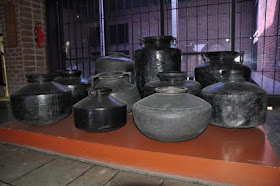Ahmedabad City Museum is situated on the bank of the Subarmati River in the City of Ahmedabad, Gujarat. It is located across the road from the National Institute of Design and close to the Tagore Memorial Hall.



The building was designed by Corbusier in 1954. It is built around a central courtyard, similar to the design of the Havelis - the traditional buildings in the pols of the old city.

Built from brick and concrete the main gallery is accessed along a ramp from within the courtyard. To access the courtyard you must walk in under the raised building.



The internal spaces are dark and have little views to the outside and surrounding spaces. The building has a feel of being slightly fortified and inward looking.



The collection illustrates and celebrates the cities history and cultural heritage. As well as housing an historic collection of beautifully drawn maps of the city, architectural details, carvings, furniture and paintings, the museum displays examples of the metal, textile, paper and woodcrafts as well as the artefacts associated with the festivals and religons of the region.


 Carved map of the old city.
Carved map of the old city.As well as beautifully drawn and proportioned maps there are some wonderful line drawings, portraits of men from the different tribal groups within Gujarat.



Painted plaster details. The vivid colours were echoed in the painted paper manuscripts and religious hangings.

Block printed and appliqué textiles.
The clarity of the design and line caught my eye.

'Paper cuts'; intricate religious images cut from sheets of paper with increadibly fine detail, along with stencils.

 More paper in the form of a 5m high 3D model of the tomb of Hussain of Karabala, used for processions during the Muslim Festival of Muharram.
More paper in the form of a 5m high 3D model of the tomb of Hussain of Karabala, used for processions during the Muslim Festival of Muharram. I was drawn to the graphic imagery of the Mata ni Pachedi - textile temple hangings produced by the once nomadic Waghari community. Intricate drawings on fabric which tell the story of the 'Mata' or mother-godess and were used form or to hang behind the focal point of a 'makeshift' shrine.


Snakes and Ladders!

Manuscripts with minature paintings of religious subjects.

Ahmedabad was a center of resistance to the British rule of India and to the Raj. Gandhi established his Ashram on the outskirts of Ahmedabad and it was here that he held meetings and planned his campaign of non violent resistance to the British. The museum houses objects and printed material related to the Indian struggle for independence.

A cast, fabricated and raised brass Dowry Chest approximately 1metre 10cm High. These were given as gifts at a couple wedding and used to store jewellery and clothes.

A carved sacred cow and a Lingam and Yoni used for worship and veneration in Hindu temples.

There were examples of the bench seats with flip over backs

and some interesting coat hooks which once furnished homes in the city.



The courtyard contains sculpture and an example of a 'Chabutro': a bird feeder.
At the entrance to the museum the guards stool made re-use of a cycle tyre.

An Ambassador car, now an increasingly rare sight on Indian roads, stood outside the museum.












